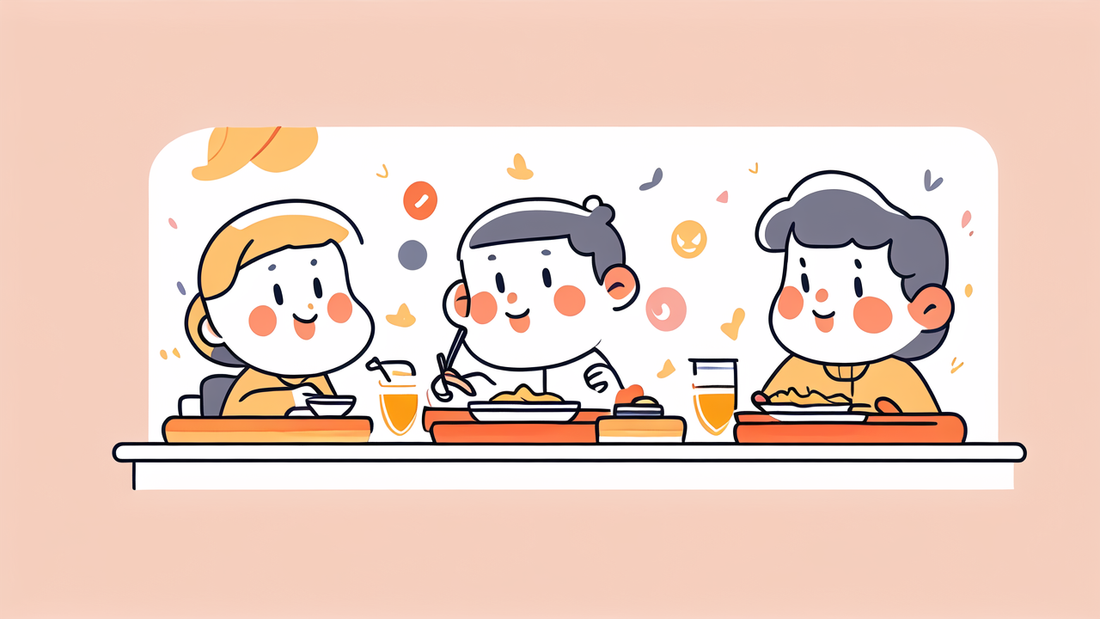
Family Dinnertime: Strengthening Bonds Over Delicious Meals
The Importance of Family Dinnertime in Childhood Nutrition
Why Family Dinners Matter for Kids
Family dinners are more than just a time to eat. They play a crucial role in a child's development.

Sharing meals together helps kids feel secure and loved. It's a chance for parents to model
good eating habits. Kids who eat with their families often have better nutrition. They tend to
eat more fruits and vegetables. Family meals can also boost language skills. Kids hear new words
and learn to express themselves. It's a time for sharing stories and building memories. Regular
family dinners can even improve academic performance. They give kids a sense of routine and stability.
How Family Dinners Influence Eating Habits
Family dinners shape a child's relationship with food. When parents eat healthy foods, kids are
more likely to try them too. Dinnertime is perfect for introducing new foods. It's less stressful
when everyone is trying something new together. Kids learn to listen to their hunger cues at
family meals. They're not rushed, so they can eat at their own pace. Family dinners also teach
portion control. Kids see what a balanced plate looks like. They learn to enjoy a variety of
foods. This can help prevent picky eating. Family meals can also reduce the risk of eating disorders.
They promote a healthy attitude towards food and body image.
Creative Ideas for Family Dinner Plates
Designing Dinner Plates for Kids
Divided plates are great for kids' meals. They make portion control easy and fun. Use colorful

sections for different food groups. Make a rainbow plate with fruits and veggies. Create fun
shapes with food. Use cookie cutters to make star-shaped sandwiches. Turn broccoli into little
trees. Make faces on plates using different foods. Use mashed potatoes for hair, cherry tomatoes
for eyes, and carrot sticks for a smile. Try themed plates for different days. Monday could be
Mexican night with tacos in each section. Use special plates for birthdays or achievements.
Let kids help design their own plates. They can draw their ideal meal and you can recreate it.
Incorporating Fun and Nutrition
Make dinner plates both fun and nutritious. Use whole grain pasta to make 'dirt' for a garden
scene. Add veggie 'flowers' on top. Create a beach scene with fish-shaped proteins and blue
jello 'water'. Make a protein 'mountain' with broccoli 'trees' at the base. Use different
colored foods to teach about nutrients. Orange foods have Vitamin A, green foods have iron,
and so on. Make a chart and let kids check off colors as they eat. Create a 'dip garden' with
hummus, guacamole, and yogurt dips. Surround it with veggie sticks for dipping. Use fun names
for healthy foods. Call broccoli 'dinosaur trees' or spinach 'muscle fuel'.
Tips for Making Family Dinner Time Successful
Engaging the Family in the Meal Planning
Get everyone involved in planning family dinners. Have a weekly menu meeting. Let each family

member choose a meal for the week. This teaches kids about balanced meals. It also ensures
everyone has a favorite dish to look forward to. Take kids grocery shopping. Let them pick
out new fruits or vegetables to try. Teach older kids to read nutrition labels. Make it a
game to find the healthiest options. Let kids help with age-appropriate cooking tasks. Even
toddlers can wash vegetables or tear lettuce. Older kids can measure ingredients or stir pots.
This builds confidence and interest in cooking. Create a family cookbook with favorite recipes.
Add new ones as you discover them together.
Setting the Right Dinner Table Environment
Create a warm, inviting atmosphere for family dinners. Use a tablecloth or placemats to make
it special. Let kids help set the table. Teach them the correct way to arrange plates and
utensils. Use cloth napkins for an eco-friendly touch. Light candles or play soft music to
create a calm mood. Ban phones and tablets from the table. This allows for distraction-free
conversation. Start a tradition of sharing the day's highlights. Ask each person to name one
good thing that happened. Keep conversation positive and inclusive. Avoid lectures or
discipline at the table. Make it a safe space for open communication. Use conversation
starters if talk lags. Keep a jar of question cards on the table. These could be silly
questions or thought-provoking ones. The key is to keep everyone engaged and enjoying the
time together.
Family dinnertime is a powerful tool for building strong, healthy families. It's not just
about the food on the plate. It's about the connections made and the habits formed. With
creative planning and a positive atmosphere, family dinners can become a cherished part of
daily life. They provide nutrition for both body and soul. So gather around the table, share
a meal, and watch your family bonds grow stronger with every bite.
